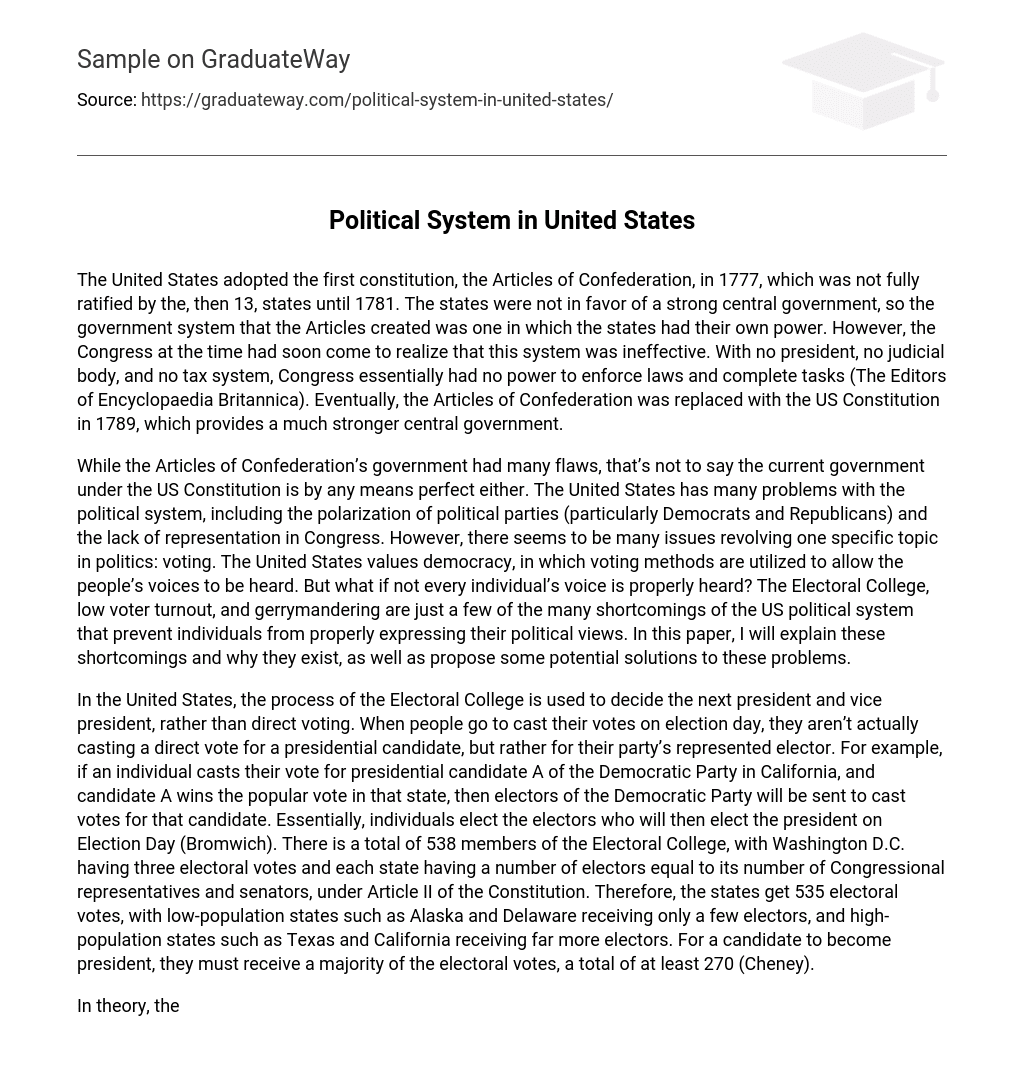The United States adopted the first constitution, the Articles of Confederation, in 1777, which was not fully ratified by the, then 13, states until 1781. The states were not in favor of a strong central government, so the government system that the Articles created was one in which the states had their own power. However, the Congress at the time had soon come to realize that this system was ineffective. With no president, no judicial body, and no tax system, Congress essentially had no power to enforce laws and complete tasks (The Editors of Encyclopaedia Britannica). Eventually, the Articles of Confederation was replaced with the US Constitution in 1789, which provides a much stronger central government.
While the Articles of Confederation’s government had many flaws, that’s not to say the current government under the US Constitution is by any means perfect either. The United States has many problems with the political system, including the polarization of political parties (particularly Democrats and Republicans) and the lack of representation in Congress. However, there seems to be many issues revolving one specific topic in politics: voting. The United States values democracy, in which voting methods are utilized to allow the people’s voices to be heard. But what if not every individual’s voice is properly heard? The Electoral College, low voter turnout, and gerrymandering are just a few of the many shortcomings of the US political system that prevent individuals from properly expressing their political views. In this paper, I will explain these shortcomings and why they exist, as well as propose some potential solutions to these problems.
In the United States, the process of the Electoral College is used to decide the next president and vice president, rather than direct voting. When people go to cast their votes on election day, they aren’t actually casting a direct vote for a presidential candidate, but rather for their party’s represented elector. For example, if an individual casts their vote for presidential candidate A of the Democratic Party in California, and candidate A wins the popular vote in that state, then electors of the Democratic Party will be sent to cast votes for that candidate. Essentially, individuals elect the electors who will then elect the president on Election Day (Bromwich). There is a total of 538 members of the Electoral College, with Washington D.C. having three electoral votes and each state having a number of electors equal to its number of Congressional representatives and senators, under Article II of the Constitution. Therefore, the states get 535 electoral votes, with low-population states such as Alaska and Delaware receiving only a few electors, and high-population states such as Texas and California receiving far more electors. For a candidate to become president, they must receive a majority of the electoral votes, a total of at least 270 (Cheney).
In theory, the Electoral College is not a bad system. It makes sense for a few representatives to be selected by the public, who then cast a presidential vote based on who the public wants. It also makes sense for the winner of the national popular vote to then be the winner of the Electoral College. However, sometimes electors don’t really follow this plan and end up voting not how they were expected to. This means that even if a presidential candidate wins the popular vote, they may lose the Electoral College and not become president, which has been the case for two of the past five elections. In 2000, Al Gore lost the Electoral College to George W. Bush, despite receiving about half a million more votes nationwide (Prokop). And in the most recent 2016 election, Donald Trump became president by winning the Electoral College vote, even though Hillary Clinton won the popular vote by almost 3 million votes (Wood).
In reality, the Electoral College is an ineffective system of voting that has many flaws. One con of the Electoral college is that it sometimes ignores the will of the people. There are millions of people currently living in the United States, but only 538 electors to represent them (ProCon.org). Additionally, those 538 electors sometimes cast votes that are in opposition to the public’s political views, which gives off the impression that the public’s vote actually does not matter, only the selected 538 elector’s votes do. The Electoral College also gives swing states such as Colorado and Nevada the privilege of suddenly changing the outcome due to their population being so closely divided politically. This means that safe states like California that typically vote Democrat have less of an impact in an election than other states that switch between a Democrat and Republican vote (Prokop).
To improve this shortcoming of the United States’ political system, I suggest abandoning the Electoral College system and instead switching over to a popular vote system consisting of direct elections. In a 2013 poll, it was revealed that 63% of Americans would choose to abolish this confusing and inconvenient method of voting (Saad) and in 2012 Donald Trump even tweeted that “The electoral college is a disaster for democracy” (Cummings). So, with this much negativity surrounding the Electoral College, why not just get rid of it? By converting to a direct popular vote system, each American’s vote would be of equal significance and they would actually be casting their vote for the president, rather than casting a vote for an elector who may or may not actually vote how they are expected to. Overall, the Electoral College has weakened and distorted the American value of democracy and should be abolished in order to improve the United States’ political system. (Lewis).





